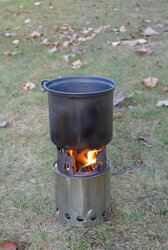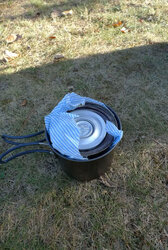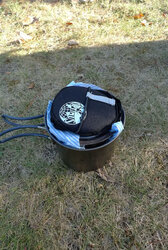(The pictures may take a moment or to to appear)
Some time ago there was a discussion on here about woodburning stoves. I bought a Bushcooker which is a copy of the Bushbuddy made by the Dutch firm Qvist (and bought from backpackinglight.co.uk). I thought I'd post about how I got on with the stove for those who are interested.
The headlines are that the cooking with wood is never going to be a quick or convenient as gas ("well, duh" I can hear you say), but it is definitely feasible as an alternative, either as a backup to gas or alcohol or as a main fuel source. It 's well worth considering if you're planning a trip to somewhere where fuel supplies are uncertain. The stove wasn't cheap (£54) but it's well made and looks like it should last a lifetime - there's no maintenance required and nothing to go wrong. Cooking with a real fire also has a certain psychological appeal that a gas stove just doesn't have.
Here it is in action:

The Bushcooker weighs 201g (according to backpackinglight.co.uk - my own scales aren't that precise) 10.5cms diameter and 10cms tall. It comes in two parts - the main stove plus a pot holder that sits on the top (and fits inside when not in use). the pot stand can also be used with an alcohol stove. It was designed to fit into a Snowpeak 900ml pot and it fits neatly into my pot which is 12cm diameter. I was also able to fit an alcohol stove and an Optimus Crux stove into the pot as well.
Here's the stove stowed away neatly in the pot (with a Caldera alcohol stove fitted inside).

and just for good measure, the gas stove as well.

At the end of the day, it's probably the weight of the fuel that you need to carry that's important. My rough estimate is that you'd need between 100 and 150 grams of fuel for cooking a meal or drink. So maybe 450 grams for three days supply to give a buffer for rainy days?
The stove works on the principle that wood when heated produces gas. The gas is drawn up between the walls of the stove and then reignited (the Bushcooker/Bushbuddy works purely through convection in contrast to some wood gasification stoves which use a battery-powered fan). If you get it right the gas ignites with a very satisfying little 'wumf'. It takes a bit of practice to get it working well, but when it's working well the stove gives off very little smoke and burns very efficiently and leaving very little ash. There was something very pleasing about using something that is at the same time very simple but also very clever.
The trick to using the stove is to get the fire burning quickly so the gasification process starts and then add just enough fuel to keep it going - add too much fuel (or the wrong sort of fuel - I found that new pine cones weren't a good idea)and the fire dies down and produces smoke for a while before it gets back into its stride.
I found that on a good day I could get the fire going within a minute or two and then it would boil 300ml of water (or a 400g can of stew/soup) in between 6 and 8 minutes. Not as fast as a gas stove, but unless you're in a real hurry, quick enough.
The performance of the stove is affected by wind so while it will work without a windshield, you do need one for the best results.
I didn't try to use the stove for frying or simmering.
I never had a problem finding fuel: a couple of minutes foraging in a suitable spot at the roadside would yield enough for a day or two's use. Even after a couple of showery days it was still possible to find reasonably dry wood (though I tended to keep a buffer of 2-3 days supply in a small stuff sack). A jacket pocketful would give enough to last a day. Twigs between pencil thickness and 1cm worked best (thicker wood burns well if you can breaking it up into small enough pieces to fit into the stove).
The stove doesn't leave burn marks on the ground and can be safely used on a picnic table. It does occasionally give off sparks or eject small burning embers. It produces only a very small quantity of ash which can be easily disposed of when cold.
Possibly the major disadvantage of the stove is the black deposits left on the bottom and sides of the pot. I found that the better I became at using the stove the less soot was left on the pot. In any event a quick scrub with a scourer was enough to get the worst of it off.
When it's cooking the stove gives off very little heat for bystanders but once you've finished cooking you can use it as a sort of mini-brazier. Although you can't do much more than warm your hands with it there was is something psychologically appealing about sitting by a fire or taking a meditative moment watching the glowing embers
I don't know how the Bushcooker/Bushbuddy compare with the DIY alternatives (I suspect that the tins used for the DIY versions would be heavier and won't be stainless steel) but I do know that I couldn't have made anything this good myself. The stainless steel construction and lack of moving parts means that it should last a lifetime.
Personally I was so convinced by the Bushcooker that the gas stove was left in my bag. To my mind, the pleasure of using the stove and of a real fire more than outweigh the inconveniences of making the fire and cleaning up afterwards. But equally there are good hard-headed grounds for considering this as a complement to another fuel source for longer trips where fuel availability is an issue.
If you want to know more, check out the backpackinglight.co.uk website - have a look at the videos. (I should say, I have no connection with either backpackinglight or with Qvist).
Some time ago there was a discussion on here about woodburning stoves. I bought a Bushcooker which is a copy of the Bushbuddy made by the Dutch firm Qvist (and bought from backpackinglight.co.uk). I thought I'd post about how I got on with the stove for those who are interested.
The headlines are that the cooking with wood is never going to be a quick or convenient as gas ("well, duh" I can hear you say), but it is definitely feasible as an alternative, either as a backup to gas or alcohol or as a main fuel source. It 's well worth considering if you're planning a trip to somewhere where fuel supplies are uncertain. The stove wasn't cheap (£54) but it's well made and looks like it should last a lifetime - there's no maintenance required and nothing to go wrong. Cooking with a real fire also has a certain psychological appeal that a gas stove just doesn't have.
Here it is in action:
The Bushcooker weighs 201g (according to backpackinglight.co.uk - my own scales aren't that precise) 10.5cms diameter and 10cms tall. It comes in two parts - the main stove plus a pot holder that sits on the top (and fits inside when not in use). the pot stand can also be used with an alcohol stove. It was designed to fit into a Snowpeak 900ml pot and it fits neatly into my pot which is 12cm diameter. I was also able to fit an alcohol stove and an Optimus Crux stove into the pot as well.
Here's the stove stowed away neatly in the pot (with a Caldera alcohol stove fitted inside).
and just for good measure, the gas stove as well.
At the end of the day, it's probably the weight of the fuel that you need to carry that's important. My rough estimate is that you'd need between 100 and 150 grams of fuel for cooking a meal or drink. So maybe 450 grams for three days supply to give a buffer for rainy days?
The stove works on the principle that wood when heated produces gas. The gas is drawn up between the walls of the stove and then reignited (the Bushcooker/Bushbuddy works purely through convection in contrast to some wood gasification stoves which use a battery-powered fan). If you get it right the gas ignites with a very satisfying little 'wumf'. It takes a bit of practice to get it working well, but when it's working well the stove gives off very little smoke and burns very efficiently and leaving very little ash. There was something very pleasing about using something that is at the same time very simple but also very clever.
The trick to using the stove is to get the fire burning quickly so the gasification process starts and then add just enough fuel to keep it going - add too much fuel (or the wrong sort of fuel - I found that new pine cones weren't a good idea)and the fire dies down and produces smoke for a while before it gets back into its stride.
I found that on a good day I could get the fire going within a minute or two and then it would boil 300ml of water (or a 400g can of stew/soup) in between 6 and 8 minutes. Not as fast as a gas stove, but unless you're in a real hurry, quick enough.
The performance of the stove is affected by wind so while it will work without a windshield, you do need one for the best results.
I didn't try to use the stove for frying or simmering.
I never had a problem finding fuel: a couple of minutes foraging in a suitable spot at the roadside would yield enough for a day or two's use. Even after a couple of showery days it was still possible to find reasonably dry wood (though I tended to keep a buffer of 2-3 days supply in a small stuff sack). A jacket pocketful would give enough to last a day. Twigs between pencil thickness and 1cm worked best (thicker wood burns well if you can breaking it up into small enough pieces to fit into the stove).
The stove doesn't leave burn marks on the ground and can be safely used on a picnic table. It does occasionally give off sparks or eject small burning embers. It produces only a very small quantity of ash which can be easily disposed of when cold.
Possibly the major disadvantage of the stove is the black deposits left on the bottom and sides of the pot. I found that the better I became at using the stove the less soot was left on the pot. In any event a quick scrub with a scourer was enough to get the worst of it off.
When it's cooking the stove gives off very little heat for bystanders but once you've finished cooking you can use it as a sort of mini-brazier. Although you can't do much more than warm your hands with it there was is something psychologically appealing about sitting by a fire or taking a meditative moment watching the glowing embers
I don't know how the Bushcooker/Bushbuddy compare with the DIY alternatives (I suspect that the tins used for the DIY versions would be heavier and won't be stainless steel) but I do know that I couldn't have made anything this good myself. The stainless steel construction and lack of moving parts means that it should last a lifetime.
Personally I was so convinced by the Bushcooker that the gas stove was left in my bag. To my mind, the pleasure of using the stove and of a real fire more than outweigh the inconveniences of making the fire and cleaning up afterwards. But equally there are good hard-headed grounds for considering this as a complement to another fuel source for longer trips where fuel availability is an issue.
If you want to know more, check out the backpackinglight.co.uk website - have a look at the videos. (I should say, I have no connection with either backpackinglight or with Qvist).



